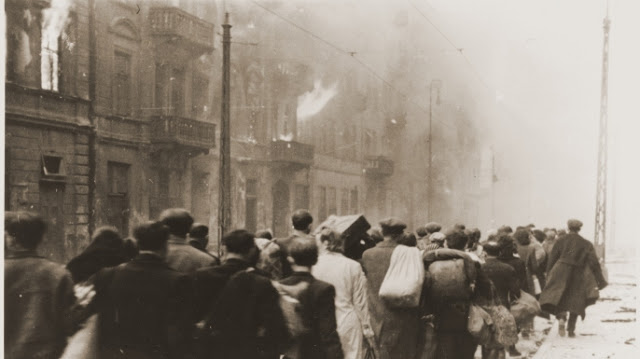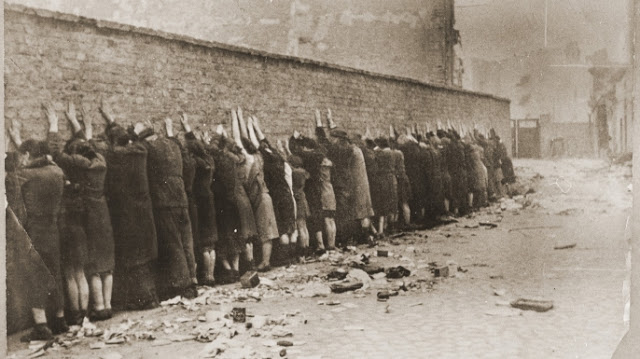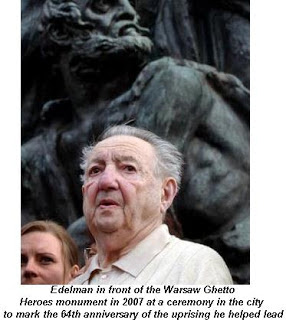Remembering the Warsaw Ghetto Uprising
Last week was the 75th anniversary
of the Warsaw Ghetto Uprising. You would have been forgiven for
having missed it. The anniversary of the founding of the Israeli state,
which was also on 19th April this year, took precedence in the mass media and
the Zionist press. Given the choice between a tale of Jewish heroism
against impossible odds, fighting fascism and racism or tales of heroic
Israelis massacring Palestinian civilians and creating ¾ million Palestinian
refugees, there was no choice.
of the Warsaw Ghetto Uprising. You would have been forgiven for
having missed it. The anniversary of the founding of the Israeli state,
which was also on 19th April this year, took precedence in the mass media and
the Zionist press. Given the choice between a tale of Jewish heroism
against impossible odds, fighting fascism and racism or tales of heroic
Israelis massacring Palestinian civilians and creating ¾ million Palestinian
refugees, there was no choice.
Earlier in the year we had Holocaust Memorial Day, a saccharine event
whose primary purpose is to depoliticise the Holocaust, the how and why it
happened. No uncomfortable comparisons between New Labour and
Theresa May’s ‘climate of extreme hostility’ to immigrants and the failure to
rescue Europe’s Jews. No searing questions about how much of the
Establishment and their rabid press supported Hitler up and until the invasion
of Poland. Even fewer questions about the role of the Zionist
movement during the Holocaust.
whose primary purpose is to depoliticise the Holocaust, the how and why it
happened. No uncomfortable comparisons between New Labour and
Theresa May’s ‘climate of extreme hostility’ to immigrants and the failure to
rescue Europe’s Jews. No searing questions about how much of the
Establishment and their rabid press supported Hitler up and until the invasion
of Poland. Even fewer questions about the role of the Zionist
movement during the Holocaust.
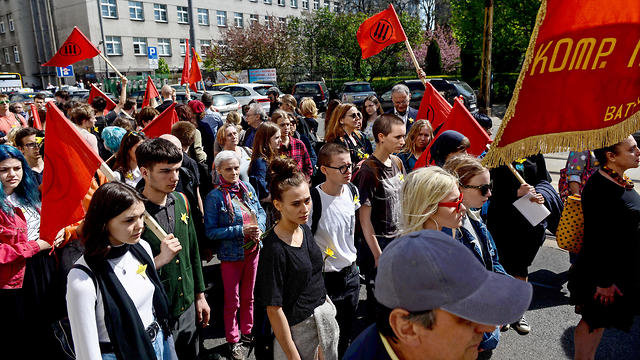 |
| Poland stands at attention for those slain (Photo: Reuters) |
The
Warsaw Ghetto Uprising was however commemorated in Poland. There were the
government’s own commemorations led by the President Andrzej Duda but hundreds
attended independent commemorations, refusing to attend those organised by a
government which, earlier in the year, passed legislation making it a criminal
offence to accuse Poles of having collaborated with the Nazi occupation (which
many did).
Warsaw Ghetto Uprising was however commemorated in Poland. There were the
government’s own commemorations led by the President Andrzej Duda but hundreds
attended independent commemorations, refusing to attend those organised by a
government which, earlier in the year, passed legislation making it a criminal
offence to accuse Poles of having collaborated with the Nazi occupation (which
many did).
Israeli leaders stayed away because they preferred to celebrate the Palestinian Naqba (catastrophe) to attending the commemoration of the Warsaw Ghetto uprisings.
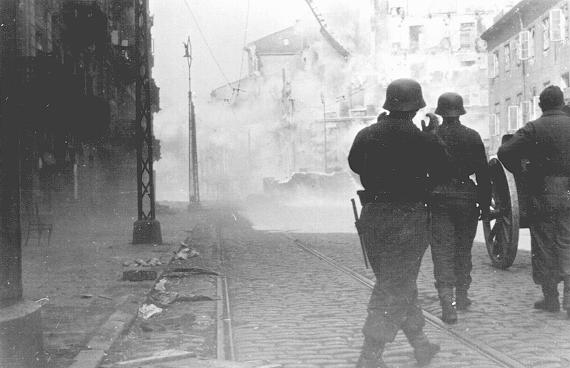 |
| German soldiers direct artillery against a pocket of resistance during the Warsaw ghetto uprising. Warsaw, Poland, April 19-May 16, 1943. — US Holocaust Memorial Museum |
It is not hard to see
why the Zionist movement and their court servants – the John Manns, Joan
Ryans, Ruth Smeeths and Luciana Bergers, should have
little to say about the Uprising. For a start it was led by an anti-Zionist Jewish socialist party the Bund, [the wrong sort of Jews!] who had the loyalty of the overwhelming majority of Polish
Jews. Secondly fighting anti-Semitism has always been deprecated in
Zionist circles (unless it is the type of ‘anti-Semitism’ that is
anti-Zionism). Zionism was established on the basis of not fighting
anti-Semitism because anti-Semitism was inherent in the non-Jew, it was futile. Antisemitism was deemed by the Zionist movement to be the product of Jewish ‘homelessness’. In the words of the founder of Political Zionism,
Theodor Herzl, who wrote this at the time of the Dreyfuss Affair:
why the Zionist movement and their court servants – the John Manns, Joan
Ryans, Ruth Smeeths and Luciana Bergers, should have
little to say about the Uprising. For a start it was led by an anti-Zionist Jewish socialist party the Bund, [the wrong sort of Jews!] who had the loyalty of the overwhelming majority of Polish
Jews. Secondly fighting anti-Semitism has always been deprecated in
Zionist circles (unless it is the type of ‘anti-Semitism’ that is
anti-Zionism). Zionism was established on the basis of not fighting
anti-Semitism because anti-Semitism was inherent in the non-Jew, it was futile. Antisemitism was deemed by the Zionist movement to be the product of Jewish ‘homelessness’. In the words of the founder of Political Zionism,
Theodor Herzl, who wrote this at the time of the Dreyfuss Affair:
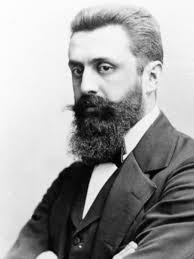 |
| Theodor Herzl – founder of Political Zionism – tolerant of anti-semitism |
Theodor Herzl
‘In
Paris… I achieved a freer attitude towards anti-Semitism, which I now began
to understand historically and to pardon. Above all, I recognise the emptiness
and futility of trying to ‘combat’ anti-Semitism.’ [Diaries, p.6]
Paris… I achieved a freer attitude towards anti-Semitism, which I now began
to understand historically and to pardon. Above all, I recognise the emptiness
and futility of trying to ‘combat’ anti-Semitism.’ [Diaries, p.6]
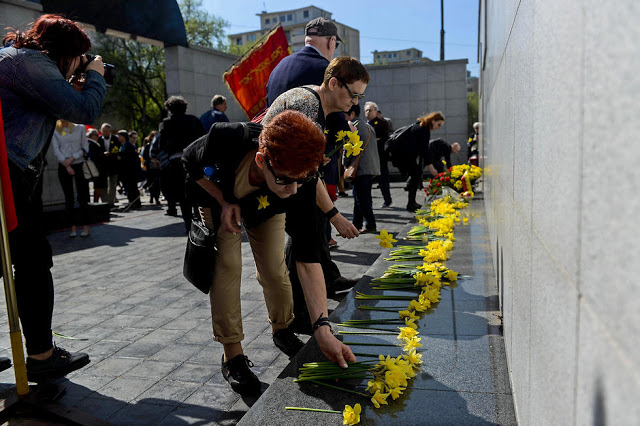 |
| Poles laying flowers on the monument to the fallen heroes |
The Warsaw Ghetto was ignored and forgotten by the
Zionist leaders in Palestine. Zionist leader Yitzhak (Antek) Zuckerman asked
why no-one left Geneva, Istanbul or Sweden, ‘if only to serve as a ‘gesture,
a sign, a hand extended as a token of sharing our fate’?’ Only the Bund and
the AK sent emissaries into the ghetto. Other movements in Europe sent their
emissaries from one ghetto to the next [Dinah Porat, p. 228, The
Blue and Yellow Stars of David]. To the Zionist movement in Palestine, the fate
of the Warsaw Ghetto was irrelevant. Their sole objective was achieving a
Jewish state. The young Zionists who fought first had to rebel against their
own Zionist parties. Zionism was irrelevant. Marek Edelman, the last Commander
of the Uprising and a member of the Bund describes how:
Zionist leaders in Palestine. Zionist leader Yitzhak (Antek) Zuckerman asked
why no-one left Geneva, Istanbul or Sweden, ‘if only to serve as a ‘gesture,
a sign, a hand extended as a token of sharing our fate’?’ Only the Bund and
the AK sent emissaries into the ghetto. Other movements in Europe sent their
emissaries from one ghetto to the next [Dinah Porat, p. 228, The
Blue and Yellow Stars of David]. To the Zionist movement in Palestine, the fate
of the Warsaw Ghetto was irrelevant. Their sole objective was achieving a
Jewish state. The young Zionists who fought first had to rebel against their
own Zionist parties. Zionism was irrelevant. Marek Edelman, the last Commander
of the Uprising and a member of the Bund describes how:
‘We joined hands
with all Jewish Zionist underground organizations. Our comrades lived and
worked with the others just as members of a close family. A mutual aim united
us. During this entire period of over half a year, there were no quarrels or
struggles, which are common among adherents of different ideologies. All
overworked themselves in organising the mutual defence of our dignity.’[Edelman,
The Ghetto Fights, pp. 110-111. Citing Second report of the Jewish workers
underground movement, 15.11.43].
with all Jewish Zionist underground organizations. Our comrades lived and
worked with the others just as members of a close family. A mutual aim united
us. During this entire period of over half a year, there were no quarrels or
struggles, which are common among adherents of different ideologies. All
overworked themselves in organising the mutual defence of our dignity.’[Edelman,
The Ghetto Fights, pp. 110-111. Citing Second report of the Jewish workers
underground movement, 15.11.43].
Marek
Edelman described how ‘the cornered partisans defended themselves bitterly
and succeeded, by truly superhuman efforts, in repulsing the attacks’ as
well as capturing two German machine guns and burning a tank. [Edelman, p.76].
Edelman described how ‘the cornered partisans defended themselves bitterly
and succeeded, by truly superhuman efforts, in repulsing the attacks’ as
well as capturing two German machine guns and burning a tank. [Edelman, p.76].
The role of the Bund and
Edelman in the Warsaw Ghetto Revolt has been airbrushed out of history by
Zionist holocaust historians. The Revolt has become another Zionist foundational
myth. [The last Bundist, Moshe Arens,] Today Zionism
uses the Revolt for propaganda purposes, suggesting that the Resistance was
solely composed of young Zionist fighters.
Edelman in the Warsaw Ghetto Revolt has been airbrushed out of history by
Zionist holocaust historians. The Revolt has become another Zionist foundational
myth. [The last Bundist, Moshe Arens,] Today Zionism
uses the Revolt for propaganda purposes, suggesting that the Resistance was
solely composed of young Zionist fighters.
There was another reason for Zionist hostility to Edelman. Edelman had
written an open letter to the Palestinians asking them to stop the bloodshed
and enter into peace negotiations. The letter caused outrage in Israel because
Edelman did not mention the word “terrorism.” Israeli leaders were particularly
incensed by its title: ‘Letter to Palestinian partisans’.
written an open letter to the Palestinians asking them to stop the bloodshed
and enter into peace negotiations. The letter caused outrage in Israel because
Edelman did not mention the word “terrorism.” Israeli leaders were particularly
incensed by its title: ‘Letter to Palestinian partisans’.
Ha’aretz, 9.8.02.
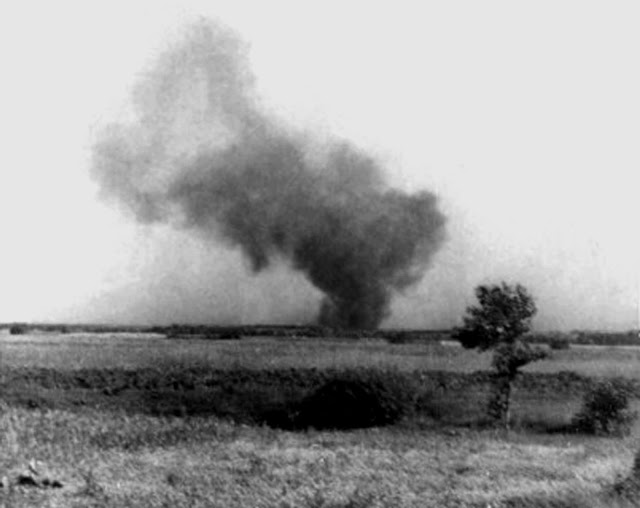 |
| Smoke from the Treblinka uprising, as seen from a railroad worker. (Credit: UtCon Collection/Alamy) |
‘Mr Edelman … wrote
in a spirit of solidarity from a fellow resistance fighter, as a former leader
of a Jewish uprising not dissimilar in desperation to the Palestinian uprising
in the occupied territories. He addressed his letter to “commanders of the Palestinian
military, paramilitary and partisan operations – to all the soldiers of the
Palestinian fighting organisations. This set up a howl of rage in the Zionist
press, who reminded their readers that Mr Edelman, despite his heroism in the
1940s, is a former supporter of the anti-Zionist socialist Bund, and can
therefore not be trusted.’ [Palestine’s partisans, Paul Foot, Guardian,
Wednesday August 21, 2002,]
in a spirit of solidarity from a fellow resistance fighter, as a former leader
of a Jewish uprising not dissimilar in desperation to the Palestinian uprising
in the occupied territories. He addressed his letter to “commanders of the Palestinian
military, paramilitary and partisan operations – to all the soldiers of the
Palestinian fighting organisations. This set up a howl of rage in the Zionist
press, who reminded their readers that Mr Edelman, despite his heroism in the
1940s, is a former supporter of the anti-Zionist socialist Bund, and can
therefore not be trusted.’ [Palestine’s partisans, Paul Foot, Guardian,
Wednesday August 21, 2002,]
What was particularly
irksome was that Edelman had consciously compared the structures of the
resistance movement in Warsaw to that of the Palestinians.’ [The Last Bundist].
irksome was that Edelman had consciously compared the structures of the
resistance movement in Warsaw to that of the Palestinians.’ [The Last Bundist].
When
Edelman died, the President of Poland attended his funeral in Warsaw on
9th October 2009 and there was a fifteen-gun salute. Because of his
support for the Palestinians, not even the lowliest clerk in the Israeli Embassy
attended. [Zionism Boycotts the Funeral of Marek Edelman, 15.10.09.] Moshe
Arens, the former Likud Foreign Minister, interviewed Edelman as part of his
research into the history of the Revisionist National Military Army ZZW, which
fought separately in Warsaw: ‘I knew his views on Israeli politics, and
did not discuss the situation in the Middle East, but as we parted I said “You
must make peace with the Arabs.” Edelman received Poland’s highest
honor, and the French Legion of Honor medal but ‘he died not having
received the recognition from Israel that he so richly deserved.’
see also
Edelman died, the President of Poland attended his funeral in Warsaw on
9th October 2009 and there was a fifteen-gun salute. Because of his
support for the Palestinians, not even the lowliest clerk in the Israeli Embassy
attended. [Zionism Boycotts the Funeral of Marek Edelman, 15.10.09.] Moshe
Arens, the former Likud Foreign Minister, interviewed Edelman as part of his
research into the history of the Revisionist National Military Army ZZW, which
fought separately in Warsaw: ‘I knew his views on Israeli politics, and
did not discuss the situation in the Middle East, but as we parted I said “You
must make peace with the Arabs.” Edelman received Poland’s highest
honor, and the French Legion of Honor medal but ‘he died not having
received the recognition from Israel that he so richly deserved.’
see also
Hero of Warsaw Ghetto Uprising, Marek Edelman, Dies at 86,
Ha’aretz 4.10.09.,
Ha’aretz 4.10.09.,
‘Marek Edelman – Death of an anti-fascist hero of the Warsaw
Jewish Resistance’
The
Revisionist Zionists made up the leadership and ranks of the Jewish police and
the leadership of ZOB had contempt for them. The ZZW obtained their arms via
their Polish fascist friends. Stiff resistance to the Nazi invasion of the
Ghetto came from the Revisionists, who were based at 7-9 Muranowska Square and
the corner of Muranowska and Nalewki streets. For two days the Polish and
Jewish Star of David flags flew, visible to thousands of Poles on the Aryan side. [S Beit Zvi, p.353, Post-Ugandan Zionism on Trial, A Study of the Factors
That Caused the Mistakes Made by the Zionist Movement During the Holocaust,
1991, Zahala, Tel Aviv]
Revisionist Zionists made up the leadership and ranks of the Jewish police and
the leadership of ZOB had contempt for them. The ZZW obtained their arms via
their Polish fascist friends. Stiff resistance to the Nazi invasion of the
Ghetto came from the Revisionists, who were based at 7-9 Muranowska Square and
the corner of Muranowska and Nalewki streets. For two days the Polish and
Jewish Star of David flags flew, visible to thousands of Poles on the Aryan side. [S Beit Zvi, p.353, Post-Ugandan Zionism on Trial, A Study of the Factors
That Caused the Mistakes Made by the Zionist Movement During the Holocaust,
1991, Zahala, Tel Aviv]
Some
five to six thousand Jews are estimated to have escaped from the ghetto to the
‘Aryan’ side of Warsaw and to have remained hidden till the end of
1943. In Palestine there was panic that the revolts ‘would
ultimately deprive the Yishuv of the cream of Europe’s potential pioneering
force.’ Melech Neustadt wanted the youth movements in Palestine to
instruct their comrades ‘to abandon their communities, save themselves, and
thereby stop the armed uprisings.’ The Zionist youth in Europe, such as
Antek Zuckerman and Zivia Lubetkin refused on principle to leave. Hayka
Klinger, who arrived in Palestine in March 1944, told the Histadrut Executive
that ‘we received an order not to organize any more defence.’ [i] The
Zionist leadership sought to extricate the leaders of the ghetto fighters as
they were more valuable in Palestine than in leading the resistance in the
ghettos. Klinger told Histadrut that ‘Without a people, a people’s
avant-garde is of no value. If rescue it is, then the entire people must be
rescued. If it is to be annihilation, then the avante-garde too shall be
annihilated.’ [Zertal, The Politics of Nationhood, p.33
five to six thousand Jews are estimated to have escaped from the ghetto to the
‘Aryan’ side of Warsaw and to have remained hidden till the end of
1943. In Palestine there was panic that the revolts ‘would
ultimately deprive the Yishuv of the cream of Europe’s potential pioneering
force.’ Melech Neustadt wanted the youth movements in Palestine to
instruct their comrades ‘to abandon their communities, save themselves, and
thereby stop the armed uprisings.’ The Zionist youth in Europe, such as
Antek Zuckerman and Zivia Lubetkin refused on principle to leave. Hayka
Klinger, who arrived in Palestine in March 1944, told the Histadrut Executive
that ‘we received an order not to organize any more defence.’ [i] The
Zionist leadership sought to extricate the leaders of the ghetto fighters as
they were more valuable in Palestine than in leading the resistance in the
ghettos. Klinger told Histadrut that ‘Without a people, a people’s
avant-garde is of no value. If rescue it is, then the entire people must be
rescued. If it is to be annihilation, then the avante-garde too shall be
annihilated.’ [Zertal, The Politics of Nationhood, p.33
The Zionist leaders saw the subsequent risings in
other ghettos as ‘a kind of betrayal of the overriding principle of the
homeland.’ [Zertal, p.44] Yet despite this Ben Gurion later claimed
that the heroism of the ghetto fighters owed its inspiration to the Zionist
fight in Palestine. The ghetto fighters were ‘retrospectively conscripted’ into
the Zionist terror groups. ‘We fought here and they fought there’ according
to Palmach commander Yitzhak Sadeh.[Zertal, pp. 25-26]. The
resistance of the Jewish ghetto fighters became intertwined with the heroic
myth of the Zionist fight for Palestine. See The
anti-Zionist Bund led the Jewish Resistance in Poland whilst the Zionist
Movement abandoned the Jews
other ghettos as ‘a kind of betrayal of the overriding principle of the
homeland.’ [Zertal, p.44] Yet despite this Ben Gurion later claimed
that the heroism of the ghetto fighters owed its inspiration to the Zionist
fight in Palestine. The ghetto fighters were ‘retrospectively conscripted’ into
the Zionist terror groups. ‘We fought here and they fought there’ according
to Palmach commander Yitzhak Sadeh.[Zertal, pp. 25-26]. The
resistance of the Jewish ghetto fighters became intertwined with the heroic
myth of the Zionist fight for Palestine. See The
anti-Zionist Bund led the Jewish Resistance in Poland whilst the Zionist
Movement abandoned the Jews
The article below contains a number of mistakes and
is slanted towards a Zionist version of events. Nonetheless it is an
interesting description of the events of 75 years ago. I also recommend
you read Marek Edelman’s account of the Ghetto Uprising, The Ghetto Fights.
is slanted towards a Zionist version of events. Nonetheless it is an
interesting description of the events of 75 years ago. I also recommend
you read Marek Edelman’s account of the Ghetto Uprising, The Ghetto Fights.
Tony Greenstein
On
this day in 1943, a band of Jewish resistance fighters launched an armed
insurrection against the Nazis. They were proud socialists and
internationalists.
this day in 1943, a band of Jewish resistance fighters launched an armed
insurrection against the Nazis. They were proud socialists and
internationalists.
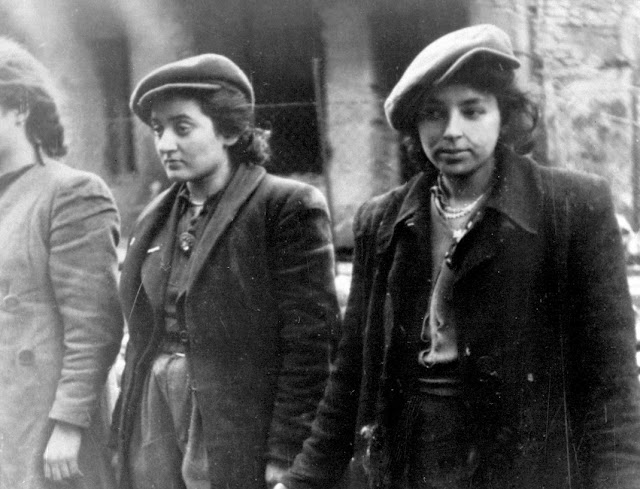 |
| Jewish resistance fighters during the Warsaw Ghetto Uprising. WWII War Crimes Records |
On
the eve of Passover 1943 — the nineteenth of April — a group of several
hundred poorly armed young Jews began the Warsaw Ghetto Uprising, one of the
first insurrections against Nazism.
the eve of Passover 1943 — the nineteenth of April — a group of several
hundred poorly armed young Jews began the Warsaw Ghetto Uprising, one of the
first insurrections against Nazism.
For
a small group of fighters, realizing — in the lyrical words of one militant —
that “dying with arms is more beautiful than without,” an isolated group of
Jewish militants resisted for twenty-nine days against a much larger foe,
motivated by a desire to kill as many fascists as they could before they
themselves were killed. The uprising, etched into the collective memory of
postwar Jewry, remains emotive and emboldening.
a small group of fighters, realizing — in the lyrical words of one militant —
that “dying with arms is more beautiful than without,” an isolated group of
Jewish militants resisted for twenty-nine days against a much larger foe,
motivated by a desire to kill as many fascists as they could before they
themselves were killed. The uprising, etched into the collective memory of
postwar Jewry, remains emotive and emboldening.
That
their heroism was a crucial part of the war is disputed by nobody today. But
less known is the extent to which the uprising, far from being a spontaneous
one of the masses, was the product of planning and preparation from a
relatively small — incredibly young — group of Jewish radicals.
their heroism was a crucial part of the war is disputed by nobody today. But
less known is the extent to which the uprising, far from being a spontaneous
one of the masses, was the product of planning and preparation from a
relatively small — incredibly young — group of Jewish radicals.
The Ghetto
Within
a few weeks of the Nazi consolidation of Poland, Governor Hans Frank ordered
four hundred thousand Warsaw Jews to enter a ghetto. By November 1940,
around five hundred thousand Jews from across Poland had been sealed
behind its walls, severed from the outside world and plunged into social
isolation. Surrounded by a ten-foot-high barrier, the creation of the ghetto
meant the relocation of approximately 30 percent of Warsaw’s population into
2.6 percent of the city, the designated area being no more than two and a
half miles long and having previously housed fewer than 160,000 people.
a few weeks of the Nazi consolidation of Poland, Governor Hans Frank ordered
four hundred thousand Warsaw Jews to enter a ghetto. By November 1940,
around five hundred thousand Jews from across Poland had been sealed
behind its walls, severed from the outside world and plunged into social
isolation. Surrounded by a ten-foot-high barrier, the creation of the ghetto
meant the relocation of approximately 30 percent of Warsaw’s population into
2.6 percent of the city, the designated area being no more than two and a
half miles long and having previously housed fewer than 160,000 people.
In
the ghetto, Jews were forced to live in chronic hunger and poverty. Many
families inhabited single rooms, and the dire lack of food meant that
roughly one hundred thousand people survived on no more than a single bowl
of soup per day. The sanitation system collapsed, and disease became rampant.
By March 1942 onwards, five thousand people died each month from disease
and malnutrition.
the ghetto, Jews were forced to live in chronic hunger and poverty. Many
families inhabited single rooms, and the dire lack of food meant that
roughly one hundred thousand people survived on no more than a single bowl
of soup per day. The sanitation system collapsed, and disease became rampant.
By March 1942 onwards, five thousand people died each month from disease
and malnutrition.
The
situation was dire — and yet, the initial response of the Jewish community
leadership was one of inaction. Following the creation of the Judenrat (Jewish
Council) — a collaborationist organization established with Nazi approval to
allow easier implementation of anti-Jewish policies — some inhabitants fell
into a false sense of security. An attitude permeated the ghetto, proffered
through the lens of Jewish history, that Nazism was just another form of persecution
that the Jewish people must suffer and outlast.
situation was dire — and yet, the initial response of the Jewish community
leadership was one of inaction. Following the creation of the Judenrat (Jewish
Council) — a collaborationist organization established with Nazi approval to
allow easier implementation of anti-Jewish policies — some inhabitants fell
into a false sense of security. An attitude permeated the ghetto, proffered
through the lens of Jewish history, that Nazism was just another form of persecution
that the Jewish people must suffer and outlast.
Others
— such as the Hashomer Hatzair militant Shmuel Braslaw — began to recognize a
jealous respect for the Germans among the ghetto’s residents. “Our young people
learn to doff their caps when encountering Germans,” wrote Braslaw in an
internal document, “smiling smiles of servitude and obedience . . .
but deep in their hearts burns a dream: to be like [the Germans] — handsome,
strong and self-confident. To be able to kick, beat and insult, unpunished. To
despise others, as the Germans despise Jews today.”
— such as the Hashomer Hatzair militant Shmuel Braslaw — began to recognize a
jealous respect for the Germans among the ghetto’s residents. “Our young people
learn to doff their caps when encountering Germans,” wrote Braslaw in an
internal document, “smiling smiles of servitude and obedience . . .
but deep in their hearts burns a dream: to be like [the Germans] — handsome,
strong and self-confident. To be able to kick, beat and insult, unpunished. To
despise others, as the Germans despise Jews today.”
Against
this demoralization, circles of defiance could be found in the
self-organization of the left-wing of the Jewish community. Communists,
Socialist-Zionists of varying descriptions, and social democrats organized
themselves into sections in the ghetto, aiming to transform the misery into
meaningful political organization. All parties — the Bund, a social-democratic mass
organization that had enjoyed huge pre-war popularity; the Marxist-Zionist
youth group Hashomer Hatzair;
the left-wing Zionist party Left Poale Zion; and the
Communist Party dedicated themselves to this strategy, organizing cells that
sought to revive collectivist attitudes among an emotionally crippled and
disaffected Jewish youth.
this demoralization, circles of defiance could be found in the
self-organization of the left-wing of the Jewish community. Communists,
Socialist-Zionists of varying descriptions, and social democrats organized
themselves into sections in the ghetto, aiming to transform the misery into
meaningful political organization. All parties — the Bund, a social-democratic mass
organization that had enjoyed huge pre-war popularity; the Marxist-Zionist
youth group Hashomer Hatzair;
the left-wing Zionist party Left Poale Zion; and the
Communist Party dedicated themselves to this strategy, organizing cells that
sought to revive collectivist attitudes among an emotionally crippled and
disaffected Jewish youth.
In
dark times, the cell structures of youth organizations provided a social and
psychological anchor against hunger and depression. “The day I was able to
re-establish contact with my group,” wrote the Young Communist militant
dark times, the cell structures of youth organizations provided a social and
psychological anchor against hunger and depression. “The day I was able to
re-establish contact with my group,” wrote the Young Communist militant
Dora Goldkorn, “was one of the
happiest days in my hard, tragic ghetto life.” In the project to develop a
resistance leadership among the youth, keeping spirits high was crucial; acts
of friendship such as the sharing of food were as important as distributing
anti-Nazi literature.
happiest days in my hard, tragic ghetto life.” In the project to develop a
resistance leadership among the youth, keeping spirits high was crucial; acts
of friendship such as the sharing of food were as important as distributing
anti-Nazi literature.
By
1942, the various youth organizations felt confident enough to consider the
formation of an “Anti-Fascist Bloc.” On the insistence of the Communists, a
manifesto was drafted that sought to unite the Jewish left in the Warsaw
Ghetto, with the hope of generalizing this political unity across other
ghettos.
1942, the various youth organizations felt confident enough to consider the
formation of an “Anti-Fascist Bloc.” On the insistence of the Communists, a
manifesto was drafted that sought to unite the Jewish left in the Warsaw
Ghetto, with the hope of generalizing this political unity across other
ghettos.
Calling
for a “national front” against the occupation, for the unity of all progressive
forces on the basis of common demands and for armed antifascism, the manifesto
echoed the pre-war Popular Fronts in its organizational methodology.
for a “national front” against the occupation, for the unity of all progressive
forces on the basis of common demands and for armed antifascism, the manifesto
echoed the pre-war Popular Fronts in its organizational methodology.
The
Left Poale Zion enthusiastically joined, as did the Hashomer Hatzair — who
re-emphasized their fidelity to the Soviet Union, despite the Kremlin’s
opposition to Zionism. The Bund, however, were less reliable, due to their
historic anticommunism and rejection of specifically Jewish armed action; a
party that resolutely stated Poland was the home for Polish Jews, many Bundists
refused avenues other than Polish-Jewish unity of action.
Left Poale Zion enthusiastically joined, as did the Hashomer Hatzair — who
re-emphasized their fidelity to the Soviet Union, despite the Kremlin’s
opposition to Zionism. The Bund, however, were less reliable, due to their
historic anticommunism and rejection of specifically Jewish armed action; a
party that resolutely stated Poland was the home for Polish Jews, many Bundists
refused avenues other than Polish-Jewish unity of action.
The
paper of the Anti-Fascist Bloc, Der Ruf, reached publication twice.
Its contents overwhelmingly focused on applauding Soviet resistance and urging
the ghetto inhabitants to hold out for imminent liberation at the hands of the
Red Army.
paper of the Anti-Fascist Bloc, Der Ruf, reached publication twice.
Its contents overwhelmingly focused on applauding Soviet resistance and urging
the ghetto inhabitants to hold out for imminent liberation at the hands of the
Red Army.
The
bloc’s fighting squads contained militants belonging to all varieties of labor
movement groups, but the lynchpin of the organization was Pinkus Kartin.
A stalwart of communism in prewar Poland and a veteran of the International
Brigades to Spain, Kartin was a leader both politically and militarily. To the
historian Israel Gutman,
who himself was active with Hashomer Hatzair in his youth, Kartin “undoubtedly
impressed” the underground’s young and inexperienced cadre.
bloc’s fighting squads contained militants belonging to all varieties of labor
movement groups, but the lynchpin of the organization was Pinkus Kartin.
A stalwart of communism in prewar Poland and a veteran of the International
Brigades to Spain, Kartin was a leader both politically and militarily. To the
historian Israel Gutman,
who himself was active with Hashomer Hatzair in his youth, Kartin “undoubtedly
impressed” the underground’s young and inexperienced cadre.
It
was the arrest and murder of Kartin in June 1943 that signaled the end for
the Anti-Fascist Bloc. His arrest triggered an intense repression against the
prominent Young Communists, who saw their numbers decimated and were driven
into hiding. It is for this reason that when the Jewish Fighting Organization
(ZOB) was founded several months later, the Communists were absent at first —
although their political line was upheld and applied by those such as Abraham
Fiszelson, a Left Poale Zion leader who had been Kartin’s right-hand man and
had befriended him in Spain.
was the arrest and murder of Kartin in June 1943 that signaled the end for
the Anti-Fascist Bloc. His arrest triggered an intense repression against the
prominent Young Communists, who saw their numbers decimated and were driven
into hiding. It is for this reason that when the Jewish Fighting Organization
(ZOB) was founded several months later, the Communists were absent at first —
although their political line was upheld and applied by those such as Abraham
Fiszelson, a Left Poale Zion leader who had been Kartin’s right-hand man and
had befriended him in Spain.
During
this period, figures from the right-wing of the Jewish community formed a rival
group, the Jewish Military Union (ZZW). Led by the right-wing Zionist group
Betar and funded by high society, the ZZW relied upon ex-army officers who
could fight orthodox warfare with the Nazis using regular army discipline —
unlike the ZOB, which considered itself the armed expression of the Jewish
workers’ movement. Furthermore, the ZZW’s connections to Polish nationalists,
the antisemitic Polish government-in-exile and the right-wing
Revisionist-Zionist movement provoked suspicion among the ZOB leadership.
this period, figures from the right-wing of the Jewish community formed a rival
group, the Jewish Military Union (ZZW). Led by the right-wing Zionist group
Betar and funded by high society, the ZZW relied upon ex-army officers who
could fight orthodox warfare with the Nazis using regular army discipline —
unlike the ZOB, which considered itself the armed expression of the Jewish
workers’ movement. Furthermore, the ZZW’s connections to Polish nationalists,
the antisemitic Polish government-in-exile and the right-wing
Revisionist-Zionist movement provoked suspicion among the ZOB leadership.
By
contrast, in the eyes of Israel Gutman, the typical ZOB volunteers were “young
men in their twenties, Zionists, Communists, socialists — idealists with no
battle experience, no military training.” While the propaganda of the ZZW was
staunchly nationalistic, the ZOB’s propaganda and literature encouraged
antiracist internationalism, offered intellectual positions on the world
situation, and debated the labor movement.
contrast, in the eyes of Israel Gutman, the typical ZOB volunteers were “young
men in their twenties, Zionists, Communists, socialists — idealists with no
battle experience, no military training.” While the propaganda of the ZZW was
staunchly nationalistic, the ZOB’s propaganda and literature encouraged
antiracist internationalism, offered intellectual positions on the world
situation, and debated the labor movement.
Despite
the darkness of their times, members of the ZOB belonged to a political
tradition that desired a better world, and sought to create it through
their struggle.
the darkness of their times, members of the ZOB belonged to a political
tradition that desired a better world, and sought to create it through
their struggle.
The Resistance
The
ZOB set as its aim an anti-Nazi insurrection. However, it recognized that
paramount to achieving this was the strengthening of the organization’s
position in the wider community — it was decided that it had to involve the
intimidation and execution of Jewish collaborators with the occupiers.
ZOB set as its aim an anti-Nazi insurrection. However, it recognized that
paramount to achieving this was the strengthening of the organization’s
position in the wider community — it was decided that it had to involve the
intimidation and execution of Jewish collaborators with the occupiers.
For
ZOB militants, collaborators represented an auxiliary wing of fascism
that was instrumental in facilitating the deportation of Polish Jewry. To
demonstrate that this stance would not be accepted in the ghetto, ZOB militants
chose to execute Jewish policeman Jacob Lejkin. For his “dedication” in
deporting Jews to Auschwitz, Lejkin was shot, and his example triggered
widespread panic in the collaborating establishment. This was followed by the
execution of Alfred Nossig in February 1943. Józef Szeryński, the former head
of the ghetto police, committed suicide to avoid his own fate.
ZOB militants, collaborators represented an auxiliary wing of fascism
that was instrumental in facilitating the deportation of Polish Jewry. To
demonstrate that this stance would not be accepted in the ghetto, ZOB militants
chose to execute Jewish policeman Jacob Lejkin. For his “dedication” in
deporting Jews to Auschwitz, Lejkin was shot, and his example triggered
widespread panic in the collaborating establishment. This was followed by the
execution of Alfred Nossig in February 1943. Józef Szeryński, the former head
of the ghetto police, committed suicide to avoid his own fate.
These
acts ensured ZOB’s centrality in the resistance movement, and also encouraged
resistance from beyond their ranks. They aimed to prove that challenging
collaboration was both possible and a moral duty — and within a short period of
time had won many ghetto inhabitants to this position.
acts ensured ZOB’s centrality in the resistance movement, and also encouraged
resistance from beyond their ranks. They aimed to prove that challenging
collaboration was both possible and a moral duty — and within a short period of
time had won many ghetto inhabitants to this position.
As
the months progressed, the specter of death became ever-present. Between
June and September 1942, three hundred thousand Jews had been deported or
murdered, a destruction of the Polish Jewish community. In these desperate
circumstances, people lost everyone and many young people began to dispense
with anxieties about protecting their families and commit instead to militant
political activity. Simply put, the more Jews were murdered in the ghettos, the
less personal obligations were felt by survivors, and the more the feeling of
responsibility for causing further anguish from Nazi reprisals receded.
the months progressed, the specter of death became ever-present. Between
June and September 1942, three hundred thousand Jews had been deported or
murdered, a destruction of the Polish Jewish community. In these desperate
circumstances, people lost everyone and many young people began to dispense
with anxieties about protecting their families and commit instead to militant
political activity. Simply put, the more Jews were murdered in the ghettos, the
less personal obligations were felt by survivors, and the more the feeling of
responsibility for causing further anguish from Nazi reprisals receded.
Contempt
was shown for the self-determined martyrdom of Adam Czerniakow, the Judenrat leader
who committed suicide in July 1942. For young Jewish socialists such as the
prominent Bundist Marek Edelman, Czerniakow had “made his death his own private
business,” a symbol of privilege in contrast to Edelman and his working-class
comrades awaiting their turn on the deportation lists. For them, he said, the
overwhelming sentiment in these times was that political leadership
necessitated that “one should die with a bang.”
was shown for the self-determined martyrdom of Adam Czerniakow, the Judenrat leader
who committed suicide in July 1942. For young Jewish socialists such as the
prominent Bundist Marek Edelman, Czerniakow had “made his death his own private
business,” a symbol of privilege in contrast to Edelman and his working-class
comrades awaiting their turn on the deportation lists. For them, he said, the
overwhelming sentiment in these times was that political leadership
necessitated that “one should die with a bang.”
The
Uprising
Uprising
In
many senses, the hopes of the Left in calling for a common struggle against
Nazi barbarity had outlived its constituency: the Jewish community was in the
process of being exterminated. What now mattered was the initiative young
leftists took upon themselves — and the majority favored an uprising.
many senses, the hopes of the Left in calling for a common struggle against
Nazi barbarity had outlived its constituency: the Jewish community was in the
process of being exterminated. What now mattered was the initiative young
leftists took upon themselves — and the majority favored an uprising.
On
the morning of Monday, January 18, six months after the first mass
deportations of Warsaw Jews (which reduced the number of ghetto inhabitants
from four hundred thousand to approximately seventy to eighty thousand),
ZOB militants emerged from the crowds of deportees to attack German soldiers,
killing several. A series of attacks followed over four days, where militants
infiltrated lines of slave laborers marching towards the Umschlagplatz [Deportation
of Jews], stepped out of rank at a given signal, and assassinated their German
guards. Though scores of ZOB fighters fell, the confusion created by the
fighting allowed some to flee — and demonstrated to others that Nazi bodies
could also fall in the ghetto.
the morning of Monday, January 18, six months after the first mass
deportations of Warsaw Jews (which reduced the number of ghetto inhabitants
from four hundred thousand to approximately seventy to eighty thousand),
ZOB militants emerged from the crowds of deportees to attack German soldiers,
killing several. A series of attacks followed over four days, where militants
infiltrated lines of slave laborers marching towards the Umschlagplatz [Deportation
of Jews], stepped out of rank at a given signal, and assassinated their German
guards. Though scores of ZOB fighters fell, the confusion created by the
fighting allowed some to flee — and demonstrated to others that Nazi bodies
could also fall in the ghetto.
By
April 1943, there was a general awareness that the ghetto was to be entirely
liquidated. A general armed revolt was scheduled to happen at the next Nazi
provocation. On April 19, five thousand soldiers led by SS general
Jürgen Stroop entered the ghetto to remove the final inhabitants; in response,
approximately 220 ZOB volunteers began their attack, located in ersatz
positions in cellars, apartments, and rooftops, each armed with a single pistol
and several Molotov cocktails.
April 1943, there was a general awareness that the ghetto was to be entirely
liquidated. A general armed revolt was scheduled to happen at the next Nazi
provocation. On April 19, five thousand soldiers led by SS general
Jürgen Stroop entered the ghetto to remove the final inhabitants; in response,
approximately 220 ZOB volunteers began their attack, located in ersatz
positions in cellars, apartments, and rooftops, each armed with a single pistol
and several Molotov cocktails.
The
revolt caused chaos, catching the Nazis off guard and killing many
Wehrmacht and SS soldiers. In response, the humiliated German army, suffering
losses at the hands of prisoners they thought long defeated, initiated a policy
of systematically burning out the fighters. To paraphrase one ZOB militant, it
was the flames — not the fascists — whom the fighters lost out to. Vicious
hand-to-hand combat raged for days, and by late April coordinated warfare by
the ZOB collapsed, the conflict now largely consisting of the Germans burning
small groups of armed Jews out of bunker hideouts created to evade capture.
revolt caused chaos, catching the Nazis off guard and killing many
Wehrmacht and SS soldiers. In response, the humiliated German army, suffering
losses at the hands of prisoners they thought long defeated, initiated a policy
of systematically burning out the fighters. To paraphrase one ZOB militant, it
was the flames — not the fascists — whom the fighters lost out to. Vicious
hand-to-hand combat raged for days, and by late April coordinated warfare by
the ZOB collapsed, the conflict now largely consisting of the Germans burning
small groups of armed Jews out of bunker hideouts created to evade capture.
According
to accounts, both the red flag and the blue-and-white flag of the Zionist
movement were raised over ZOB-seized buildings. The youngest fighter killed had
been a Bundist activist aged thirteen. Though clearly inexperienced as a
fighting force, an anonymously authored Bund internal document that reached
London in June 1943 stressed the “exemplary” political unity and “fraternity”
between leftist groups in combat. The unswerving dedication to which the young
fighters of the ZOB clung to their dreams of socialism was exemplified most
movingly in a May Day rally held amid the ghetto’s ruins.
to accounts, both the red flag and the blue-and-white flag of the Zionist
movement were raised over ZOB-seized buildings. The youngest fighter killed had
been a Bundist activist aged thirteen. Though clearly inexperienced as a
fighting force, an anonymously authored Bund internal document that reached
London in June 1943 stressed the “exemplary” political unity and “fraternity”
between leftist groups in combat. The unswerving dedication to which the young
fighters of the ZOB clung to their dreams of socialism was exemplified most
movingly in a May Day rally held amid the ghetto’s ruins.
Participating
in the rally, Marek Edelman reflected that
in the rally, Marek Edelman reflected that
The
entire world, we knew, was celebrating May Day on that day and everywhere
forceful, meaningful words were being spoken. But never yet had the Internationale been
sung in conditions so different, so tragic, in a place where an entire nation
had been and was still perishing. The words and the song echoed from the
charred ruins and were, at that particular time, an indication that socialist
youth [were] still fighting in the ghetto, and that even in the face of death
they were not abandoning their ideals.
entire world, we knew, was celebrating May Day on that day and everywhere
forceful, meaningful words were being spoken. But never yet had the Internationale been
sung in conditions so different, so tragic, in a place where an entire nation
had been and was still perishing. The words and the song echoed from the
charred ruins and were, at that particular time, an indication that socialist
youth [were] still fighting in the ghetto, and that even in the face of death
they were not abandoning their ideals.
Leading
militants of the ZOB committed mass suicide on May 8, surrounded by the German
army at their base on Mila 18. By mid-May, the ghetto had been razed, and the
Great Synagogue of Warsaw personally blown up by General Stroop on May
16 to celebrate the end of Jewish resistance. A mere forty ZOB
combatants had escaped onto the “Aryan” side of Warsaw, where scores more fell
before war’s end in the subsequent city-wide uprising of 1944.
militants of the ZOB committed mass suicide on May 8, surrounded by the German
army at their base on Mila 18. By mid-May, the ghetto had been razed, and the
Great Synagogue of Warsaw personally blown up by General Stroop on May
16 to celebrate the end of Jewish resistance. A mere forty ZOB
combatants had escaped onto the “Aryan” side of Warsaw, where scores more fell
before war’s end in the subsequent city-wide uprising of 1944.
The Lesson
In our times, war criminal George
W. Bush can pay comfortable
tribute to the fighters of the Warsaw Ghetto Uprising. So can
fellow humanitarians David Cameron and Barack Obama, who both offered speeches
dripping with moralism about the heroism of the revolt. Their platitudes are
the product of the historical reduction of the event over time — something
which is likely to increase as more witnesses to the Holocaust leave us, often
with unrecorded testimony.
W. Bush can pay comfortable
tribute to the fighters of the Warsaw Ghetto Uprising. So can
fellow humanitarians David Cameron and Barack Obama, who both offered speeches
dripping with moralism about the heroism of the revolt. Their platitudes are
the product of the historical reduction of the event over time — something
which is likely to increase as more witnesses to the Holocaust leave us, often
with unrecorded testimony.
More dangerous still are active attempts to erase
the politics that produced such heroic resistance. Just this week, the
University of Vilnius in Lithuania announced that
it would honor Jewish students murdered in the Holocaust — as long as they had
not participated in left-wing political activity or anti-Nazi militancy.
the politics that produced such heroic resistance. Just this week, the
University of Vilnius in Lithuania announced that
it would honor Jewish students murdered in the Holocaust — as long as they had
not participated in left-wing political activity or anti-Nazi militancy.
Against this attack on history, the Left’s task is
to defend the fighters of the ZOB from the condescension of official patronage
or the dark possibilities of state demonization. We can only do this by
restating what so many of these people were — young militants, committed to
left-wing ideals, brimming with enthusiasm for a better world, pushed to
oblivion alongside their community.
to defend the fighters of the ZOB from the condescension of official patronage
or the dark possibilities of state demonization. We can only do this by
restating what so many of these people were — young militants, committed to
left-wing ideals, brimming with enthusiasm for a better world, pushed to
oblivion alongside their community.
Jews by birth and communal affiliation, they also
engaged in the struggle as internationalists, a determined part of a worldwide
struggle against fascism and capitalism. As weakened as they were, their
attitude — that to submit meant death, that resistance even in the face of
impossible odds was a moral imperative — inspired imprisoned Spanish
Republicans, French communist peasants, their fellow Poles watching from behind
the ghetto walls, and their fellow Jews languishing in the concentration camps.
engaged in the struggle as internationalists, a determined part of a worldwide
struggle against fascism and capitalism. As weakened as they were, their
attitude — that to submit meant death, that resistance even in the face of
impossible odds was a moral imperative — inspired imprisoned Spanish
Republicans, French communist peasants, their fellow Poles watching from behind
the ghetto walls, and their fellow Jews languishing in the concentration camps.
Their story is a reminder of the Holocaust’s
brutality and hopelessness, but also a shining example of those who in the
worst of circumstances — in the words of the partisan poet Hirsh Glik — could
never say that they have reached the final road.
brutality and hopelessness, but also a shining example of those who in the
worst of circumstances — in the words of the partisan poet Hirsh Glik — could
never say that they have reached the final road.
Posted in Blog
